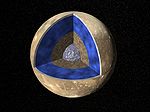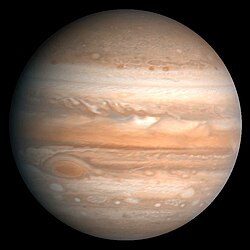Ganymedes (måne)
- För andra betydelser, se Ganymedes (olika betydelser).
| Ganymedes | |
 Ganymedes fotograferad av rymdsonden Galileo i juni 1996 | |
| Upptäckt | |
|---|---|
| Upptäckare | G. Galilei, S. Marius |
| Upptäcktsdatum | 11 januari 1610 |
| Beteckningar | |
| Alternativnamn | Jupiter III |
| Uppkallad efter | Ganymedes |
| Omloppsbana | |
| Banmedelradie | 1 070 400 km[1] |
| Excentricitet | 0,0013[1] |
| Siderisk omloppstid | 7,15455296 dygn[1] |
| Medelomloppshastighet | 10,880 km/s |
| Inklination | 0,20° (i förh.t. Jupiters ekvator)[1] |
| Måne till | Jupiter |
| Fysikaliska data | |
| Medelradie | 2634,1 ± 0,3 km (0,413 jordar) |
| Area | 87,0 miljoner km² (0,171 jordar) |
| Volym | 7,6 × 1010 km3 (0,0704 jordar) |
| Massa | 1,4819 × 1023 kg (0,025 jordar) |
| Medeldensitet | 1,942 |
| Ytgravitation (ekvatorn) | 1,428 |
| Flykthastighet | 2,741 |
| Rotationsperiod | Synkron |
| Albedo | 0,43 |
| Yttemperatur | Min: 70[2] Medel: 110[2] Max: 152[3] |
| Atmosfär | |
| Yttryck | spår |
| Sammansättning | syre |
Ganymedes är den största av Jupiters många månar och den största månen i hela solsystemet. Med en diameter på omkring 5 200 kilometer är den det nionde största objektet i solsystemet. Därmed är Ganymedes större än såväl planeten Merkurius som samtliga dvärgplaneter. Den har dock endast ungefär halva Merkurius massa.
Månen är uppkallad efter Ganymedes, en trojansk prins, som enligt myten blev bortförd av Zeus till gudarnas boning Olympos, där han verkade som munskänk.
Ganymedes, Callisto, Io och Europa kallas tillsammans för de Galileiska månarna.
Ganymedes yta är stenig och är full av kratrar.
Den 16 december 2000 meddelade NASA att det kan finnas ett hav under Ganymedes istäckta yta. Den 12 mars 2015 meddelade NASA att de faktiskt hittat ett hav begravt under 150 kilometer tjock ismassa. Havet är 100 kilometer djupt.[4]
Utforskning
De första rymdsonder som besökte Ganymedes var Pioneer 10 och Pioneer 11 på 1970-talet, vilka inte gav mycket information. Rymdsonderna Voyager 1 och Voyager 2 passerade båda Ganymedes 1979 och kunde bestämma dess storlek och man fann att Ganymedes var större än Titan vilken man tidigare hade trott varit större.
1995 gick Galileo in i bana runt Jupiter och gjorde mellan 1996 och 2000 sex nära passeringar av Ganymedes. Den närmsta passeringen var 264 km över ytan. Galileo upptäckte magnetfältet och att Ganymedes har en ocean samt tog även många bilder.
Efter Galileo har rymdsonden New Horizons passerat på sin väg mot Pluto och en topografikarta gjordes.
Upptäckt och namn

Det var Galileo Galilei som upptäckte Ganymedes den 7 januari 1610 och det var den första måne i solsystemet man upptäckte som kretsade kring en annan planet. På samma dag upptäckte han också månarna Callisto, Io och Europa. Först trodde han att det var stjärnor nära Jupiter fast sedan insåg han att det var månar till Jupiter.
Den franska astronomen Nicolas-Claude Fabri de Peiresc föreslog att månarna skulle få olika namn från släkten Medici, men hans förslag antogs inte. Simon Marius, som hävdade att han upptäckt de fyra månarna några dagar före Galilei, gav dem deras nuvarande namn. Det var dock inte förrän i mitten av 1900-talet som namnen kom i allmänt bruk.
Rotation och omlopp kring Jupiter

Ganymedes kretsar kring Jupiter på ett avstånd av 1 070 400 km, tredje bland de galileiska månarna. Det tar 7,16 dygn för Ganymedes att kretsa ett varv kring Jupiter. Dess bana är mycket lätt excentrisk och lutande mot Jupiters ekvator. Områdena för förändringar i excentricitet och banlutning är 0,0009-0,0022 respektive 0,05-0,32°. Variationerna i omloppsbanan gör att axellutningen (vinkeln mellan rotations- och banaxlarna) varierar mellan 0 och 0,33°.
Fysiska egenskaper
Sammansättning

Den genomsnittliga densiteten för Ganymedes är 1,936 g/cm3 vilket tyder på att den består av sten och vatten (främst i form av is). Isens massfraktion är mellan 46 och 50 procent (något lägre än hos Callisto). Några ytterligare flyktiga isar såsom ammoniak kan också förekomma. Viktförhållandet av järn till kisel är 1,05-1,27 av Ganymedes medan sol-förhållandet är omkring 1,8.
Inre struktur

Ganymedes verkar vara helt differentierad, bestående av en järnsulfid/järn-kärna, en silikatmantel och en yttre ismantel. Denna modell stöds av det låga värdet på dess dimensionslösa tröghetsmoment (0,3105 ± 0,0028). Den exakta tjockleken hos de olika skikten i det inre av Ganymedes beror på den antagna sammansättningen av silikater (fraktion av olivin och pyroxen) och mängden av svavel i kärnan.
Atmosfär
Ganymedes är den enda månen i solsystemet känd för att ha en magnetosfär. Den magra magnetosfären är begravd i Jupiters mycket större magnetfält. Månen har en tunn atmosfär av syre som innehåller O, O2 och eventuellt O3 (ozon). Atmosfären är som sagt ganska tunn och skyddar därför inte så bra mot kometer.
- Ganymedes terräng, tagen av rymdsonden Galileo
- Ganymedes i genomskärning
Referenser
- ^ [a b c d] ”Planetary Satellite Mean Orbital Parameters”. Jet Propulsion Laboratory, California Institute of Technology. https://ssd.jpl.nasa.gov/?sat_elem.
- ^ [a b] Delitsky, Mona L. (1 augusti 1998). ”Ice chemistry of Galilean satellites” (pdf). J.of Geophys. Res. "103" (E13): ss. 31,391–31,403. doi:. Arkiverad från originalet den 3 oktober 2006. https://web.archive.org/web/20061003013845/http://trs-new.jpl.nasa.gov/dspace/bitstream/2014/20675/1/98-1725.pdf.
- ^ Orton, G.S. (1 augusti 1996). ”Galileo Photopolarimeter-radiometer observations of Jupiter and the Galilean Satellites”. Science "274": ss. 389–391. doi:. http://adsabs.harvard.edu/abs/1996Sci...274..389O.
- ^ ”NASA’s Hubble Observations Suggest Underground Ocean on Jupiter's Largest Moon”. NASA News. 12 mars 2015. http://www.nasa.gov/press/2015/march/nasa-s-hubble-observations-suggest-underground-ocean-on-jupiters-largest-moon/#.VQJhMM26t0s. Läst 11 december 2015.
Externa länkar
 Wikimedia Commons har media som rör Ganymedes (måne).
Wikimedia Commons har media som rör Ganymedes (måne).
| ||||||||||||||
| |||||||||||||||||||||||||||||||||||||||||||||||||
|
Media som används på denna webbplats
True color image of Ganymede, obtained by the Galileo spacecraft, with enhanced contrast.
Here is the description from JPL's web entry for PIA00716:
Natural color view of Ganymede from the Galileo spacecraft during its first encounter with the satellite. North is to the top of the picture and the sun illuminates the surface from the right. The dark areas are the older, more heavily cratered regions and the light areas are younger, tectonically deformed regions. The brownish-gray color is due to mixtures of rocky materials and ice. Bright spots are geologically recent impact craters and their ejecta. The finest details that can be discerned in this picture are about 13.4 kilometers across. The images which combine for this color image were taken beginning at Universal Time 8:46:04 UT on June 26, 1996.
The Jet Propulsion Laboratory, Pasadena, CA manages the mission for NASA's Office of Space Science, Washington, DC. This image and other images and data received from Galileo are posted on the World Wide Web, on the Galileo mission home page at URL http://galileo.jpl.nasa.gov. Background information and educational context for the images can be found at http://www.jpl.nasa.gov/galileo/sepo.Diameter comparison of the Jovian moon Ganymede, Moon, and Earth.
Scale: Approximately 29 km per pixel.Animation of the 1:2:4 Laplace resonance between Io, Europa, and Ganymede. The labels indicate the ratios of orbital periods: Europa's is twice Io's, and Ganymede's is four times Io's.
Warning: do not downsize the image below its original size of 365 × 245 when used in a Wikipedia article, as the animation won't move then (at least not for all users).
Interior of Ganymede: Voyager images are used to create a global view of Ganymede. The cut-out reveals the interior structure of this icy moon. This structure consists of four layers based on measurements of Ganymede's gravity field and theoretical analyses using Ganymede's known mass, size and density. Ganymede's surface is rich in water ice and Voyager and Galileo images show features which are evidence of geological and tectonic disruption of the surface in the past. As with the Earth, these geological features reflect forces and processes deep within Ganymede's interior. Based on geochemical and geophysical models, scientists expected Ganymede's interior to either consist of: a) an undifferentiated mixture of rock and ice or b) a differentiated structure with a large lunar sized "core" of rock and possibly iron overlain by a deep layer of warm soft ice capped by a thin cold rigid ice crust. Galileo's measurement of Ganymede's gravity field during its first and second encounters with the huge moon have basically confirmed the differentiated model and allowed scientists to estimate the size of these layers more accurately. In addition the data strongly suggest that a dense metallic core exists at the center of the rock core. This metallic core suggests a greater degree of heating at sometime in Ganymede's past than had been proposed before and may be the source of Ganymede's magnetic field discovered by Galileo's space physics experiments.
Original Caption Released with Image: This processed color image of Jupiter was produced in 1990 by the U.S. Geological Survey from a Voyager 2 image captured in 1979. The colors have been enhanced to bring out detail. Zones of light-colored, ascending clouds alternate with bands of dark, descending clouds. The clouds travel around the planet in alternating eastward and westward belts at speeds of up to 540 kilometers per hour. Tremendous storms as big as Earthly continents surge around the planet. The Great Red Spot (oval shape toward the lower-left) is an enormous anticyclonic storm that drifts along its belt, eventually circling the entire planet.
This composite includes the four largest moons of Jupiter which are known as the Galilean satellites. The Galilean satellites were first seen by the Italian astronomer Galileo Galilei in 1610. Shown from left to right in order of increasing distance from Jupiter, Io is closest, followed by Europa, Ganymede, and Callisto.
The order of these satellites from the planet Jupiter helps to explain some of the visible differences among the moons. Io is subject to the strongest tidal stresses from the massive planet. These stresses generate internal heating which is released at the surface and makes Io the most volcanically active body in our solar system. Europa appears to be strongly differentiated with a rock/iron core, an ice layer at its surface, and the potential for local or global zones of water between these layers. Tectonic resurfacing brightens terrain on the less active and partially differentiated moon Ganymede. Callisto, furthest from Jupiter, appears heavily cratered at low resolutions and shows no evidence of internal activity.
North is to the top of this composite picture in which these satellites have all been scaled to a common factor of 10 kilometers (6 miles) per picture element.
The Solid State Imaging (CCD) system aboard NASA's Galileo spacecraft acquired the Io and Ganymede images in June 1996, the Europa images in September 1996, and the Callisto images in November 1997.
Launched in October 1989, the spacecraft's mission is to conduct detailed studies of the giant planet, its largest moons and the Jovian magnetic environment.Boundary between dark and light terrain on Ganymede. The photo is PIA02577 at the JPL Planetary Photojournal. It was taken by the Galileo spacecraft.
Original NASA caption:
The ancient, dark terrain of Nicholson Regio (left) shows many large impact craters, and zones of fractures oriented generally parallel to the boundary between the dark and bright regions of Jupiter's moon Ganymede. In contrast, the bright terrain of Harpagia Sulcus (right) is less cratered and relatively smooth.
The nature of the boundary between ancient, dark terrain and younger, bright terrain, the two principal terrain types on Ganymede, was explored by NASA's Galileo spacecraft on May 20, 2000. Subtle parallel ridges and grooves show that Harpagia Sulcus's land has been smoothed out over the years by tectonic processes.
North is to the top of the picture. The Sun illuminates the surface from the left. The image, centered at ?14 degrees latitude and 319 degrees longitude, covers an area approximately 213 by 97 kilometers (132 by 60 miles.) The resolution is 121 meters (about 250 feet) per picture element. The images were taken on May 20, 2000, at a range of 11,800 kilometers (about 7,300 miles).









